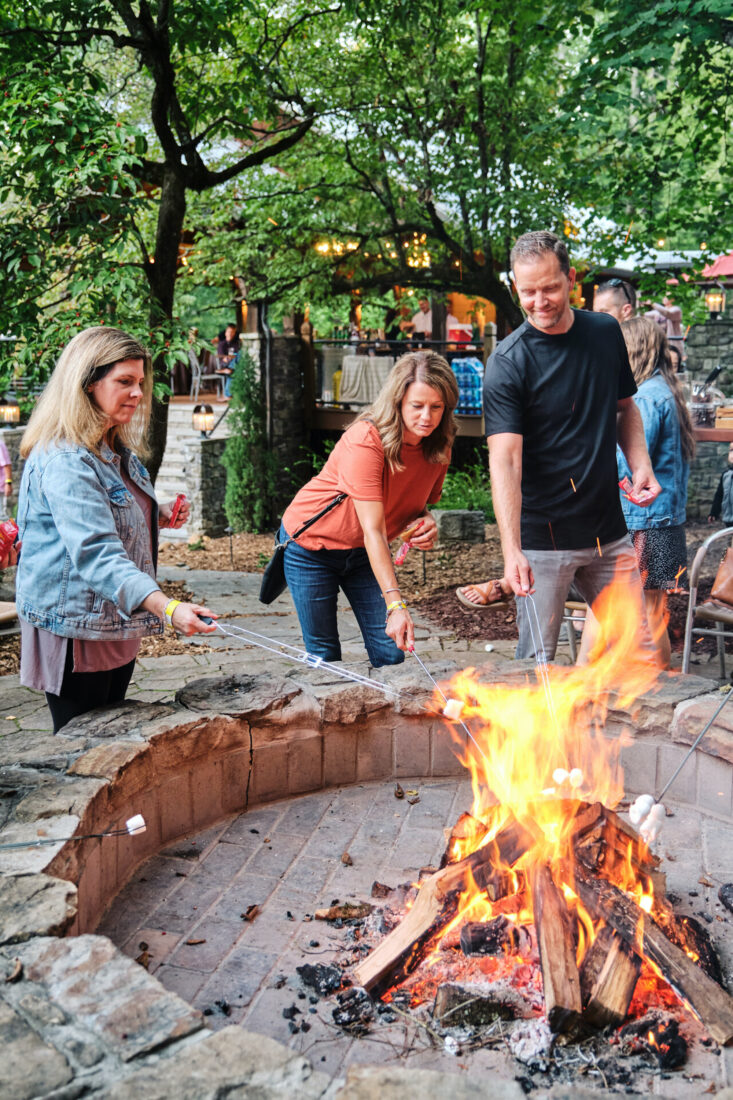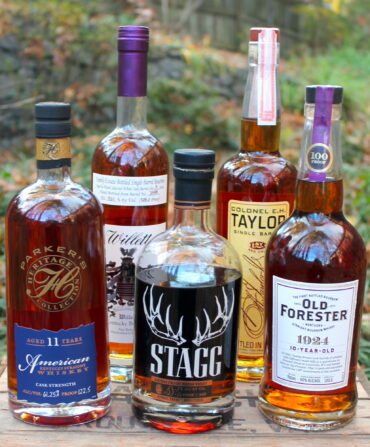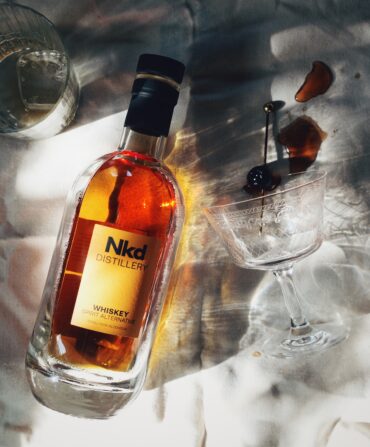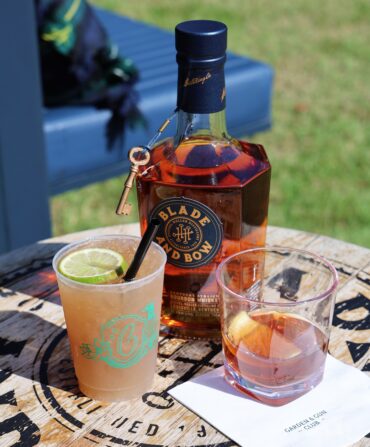One recent cold evening in a South Carolina backyard, I watched my husband, Max, and some of our friends step through a very particular social dance: the guys-around-a-fire tango. Standing next to our friend Bubba’s pit, fire-loving Max and Chase Barton, who literally stokes smoke for a living at his Martin’s Bar-B-Que Joint in Charleston, wouldn’t so much as pick up the poker until Bubba gave his blessing. Bubba asked if anyone needed a drink refresh, and then told Max and Chase it was okay to throw on another log while he walked away. The fire master had officially handed over the reins to his trusted deputies.
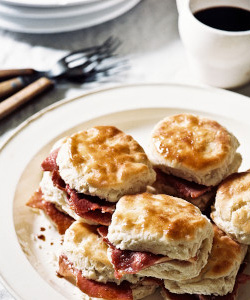
Turns out, plenty of folks abide this ritual: “It is important for one person to be in charge of the fire,” says Matt Casto, master distiller at Devils Backbone in Roseland, Virginia. “They add the logs, then tend the coals. They control the pit so it isn’t overloaded.”
In the recent issue of Garden & Gun, editor in chief Dave DiBenedetto honored backyard firepit traditions in his editor’s letter. We asked him for a few more specific pointers, plus talked to chefs, pitmasters, and fire fans around the South for some of their best advice, tools, and warm-you-up recipes.
First things first, set yourself up for success.
“Get the fire going two hours before the party,” DiBenedetto says. “That way you don’t have to fuss with pyrotechnics when guests arrive. You want hot coals that easily ignite a log when you toss it on.”
Establish who’s the fire master—whether the host or a trusted guest. “It is also important that this person is safety conscious and has the tools to extinguish the fire if necessary,” Casto says. “Have a plan for water close by.”
“Have seating that you can easily move around,” G&G contributing editor Jenny Everett says. “No one likes to sit around a fire with smoke blowing in their face.”
Dress for the occasion.
Todd Annis, the vice president of culinary operations for Cru Catering, suggests throwing on an apron to have a few extra pockets to hold your favorite tools and utensils. Annis keeps “two sets of long tongs, a metal spatula, and a large spoon for sauces and to help with grease drippings” on hand. At home, he also adds a nice local beer to that checklist.
Another pro tip from Houston Oldham, the COO of Dancing Bear Lodge & Appalachian Bistro in Townsend, Tennessee: “Never wear puffy jackets or nylon near the flame. It’ll melt your favorite jacket or shirt!”
Build a solid foundation.
“When starting a fire, I always start really small with small twigs and leaves, then gradually bigger wood,” says chef Hunter Evans of Elvie’s in Jackson, Mississippi. “Don’t go too fast.”
“When I was younger, my Papa (granddad) taught me how to build a proper fire using a ring of bricks and rocks to keep the coals contained,” Oldham says. “We’d use paper on the bottom, surround it with a ‘log cabin’ of thin cut logs, and then use longer sticks to make a teepee over it. We’d always burn tulip poplar wood in the beginning of the night as it burns hot and fast. We would mix in some well-seasoned oak to build dense, hot coals that lasted for hours.”
Be picky if you plan to cook—“Starter fluid is what a lot of people will opt for when getting their fire going. However, this will change the taste of any items you are working with,” Annis says. “Starting natural with wood chips is the best way to go, adding in a bit of charcoal to hold the temperature.”
“Be careful because some things like poison ivy have volatile oils that are dangerous,” says the plantsman Jenks Farmer. “And don’t ever try burning pallets or packing crate wood that can be saturated with pesticides that are choking.”
Know your woods.
“My favorite woods to cook with are hardwoods that burn for a long time and make nice coals such as oak and hickory,” says chef Josh Taylor of Lost Isle on Johns Island, South Carolina.
For his Midwood Smokehouse locations throughout the Carolinas, Frank Scibelli of FS Food Group uses North Carolina hickory in his smokers. “Hardwoods like oak or hickory work best and last longest, but make sure they are well seasoned first,” he says. “To start, light easily flammable kindling, then add smaller sticks and logs, and then slowly continue to add larger and larger logs until the fire grows to your liking. Then just toss in the occasional log to keep the fire going strong.”
Once it’s time to cook, chef Vincent Barcelona of Mount Pleasant, South Carolina’s BENE Hospitality might add in cherry, apple, and maple woods.
If your fire is more hangout than cookout, Jenks Farmer has a slew of fun ideas: “Make it a total sensory experience with fragrance and sounds,” he says. “I always keep a few canes of bamboo. They make the most incredible bams and booms like fireworks. Cherry laurel is a fast fun crackle. Dry sago leaves flame like a roman candle. Magnolia is slow and you can even see the leaves blistering and coming apart in layers. Magnolia wood is fun too. It’s a soft, wet, dense wood and you’ll hear the slow, eerie whistle as the water boils from inside the stem. Fig wood does the same thing.”
“The fragrance of pine needles burning takes me back to childhood when people burned big piles of red pine straw,” Farmer continues. “Of course, cedar and rosemary will give you a flash of fragrance smoke. My favorite trick is sulfur. Take a pinch of sulfur and throw it higher across the top of the fire. The tiny dust particles light up in lime, green, and bright yellow like the aurora borealis.”
Pick tools of the trade.

At the Cavalry Court hotel in College Station, Texas, chief engineer Byron Morales says his favorite tool is the Walden Backyards Fire Pit Stoker-Poker. “It’s made of heavy-duty steel and has a one-way air flow valve that helps bring a dying fire back to life.”
Ian Boden, culinary partner at the Tabard Inn in Washington, D.C., and chef and owner of the Shack in Staunton, Virginia, has a few helpful suggestions: “My preferred tool is the hand grill from Grills by Demant,” he says. “They also have an oyster hand grill and a fish basket. You should treat the fire like a hearth, not a fireplace, in the sense that you should use radiated heat from the embers to cook, rather than cooking with direct heat from the open flame. Try building the fire offset from the middle and raking hot embers over using a hand rake once they are hot enough.”
Roast oysters.

Across the board, chefs shouted out oysters as a favorite fireside snack. In Charleston, Max and I celebrate the end of yard-work weekends by picking up a couple dozen unshucked Olde Salts at Rappahannock Oyster Bar. We put the grate down over our Breeo smokeless fire pit and pour water in a cast iron skillet. We set the oysters in that above the heat and pull them off as soon as they crack open. They’re easier to shuck that way, but not totally cooked, and they’re bright and briny dunked in shallot mignonette.
“You just can’t beat a good wood-fired oyster,” says Josh Taylor of Lost Isle. “We start by making chili-chorizo compound butter and cooking the oyster with that butter and cotija cheese over the fire. When we pull it off the flame, we finish it with smoked bread crumbs, chopped chives, and grilled lemon.”
Chef Barcelona roasts his with a compound butter of garlic, lemon zest, a little cayenne pepper, and bread crumbs.
Fall for foil packs.
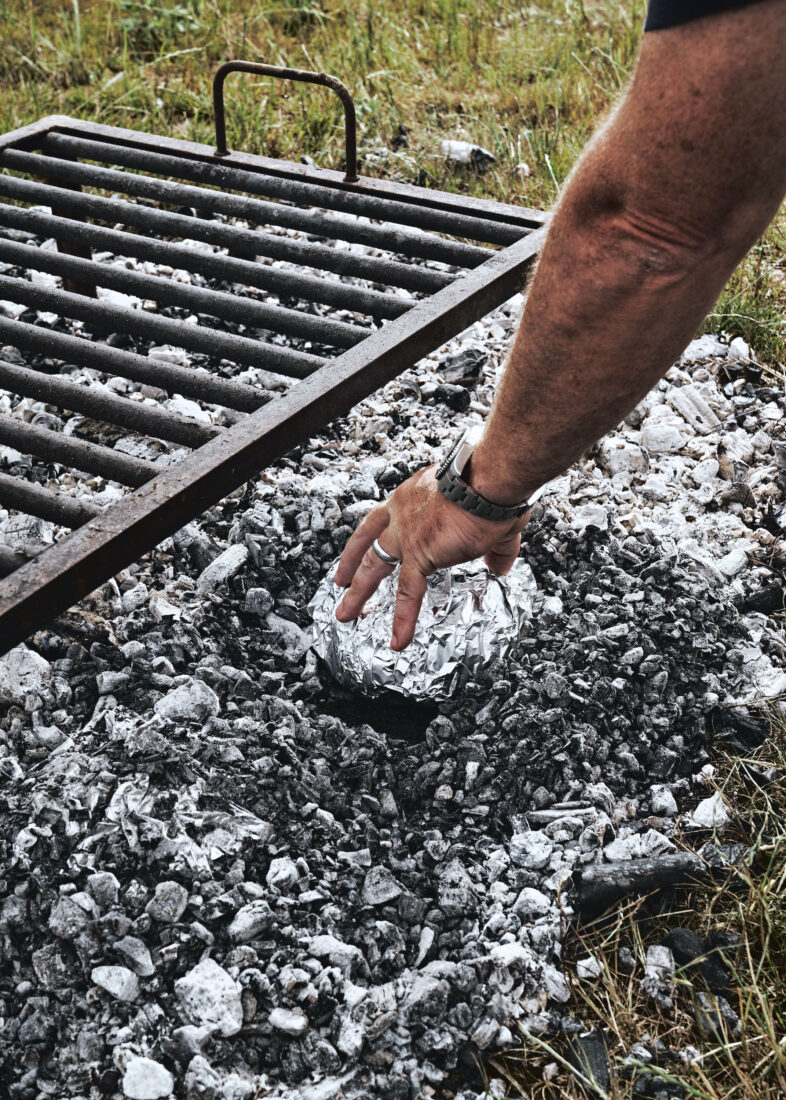
“An easy and almost foolproof way to cook a whole meal in ashes and embers is the classic Boy Scout–style foil pack,” pitmaster Pat Martin says. “You probably haven’t made these since your youth, but they are so dadgum easy to assemble and you can put together endless combinations of ingredients. The foil keeps moisture inside, which helps reduce the chances of scorching and burning the food. You can cook pretty much anything in a foil pack that you’d bake in an oven, from fish and chicken to dense fruits to most vegetables.” One of his favorite combinations is crisp pears plus a salty cheese like Manchego, drizzled with sorghum syrup or molasses.
“Many foil-pack recipes call for adding ingredients to a square of aluminum foil, then placing another sheet on top and folding up the edges to make a tight packet. This works fine, but I prefer to use a longer sheet of heavy-duty foil, placing the ingredients in the center and pulling the four corners up to meet in the center over the top of the food, creating a tent-like structure that resembles a wrapped Hershey’s Kiss. This makes the packs easier to open for checking on doneness or adding additional ingredients during the cooking process.”
Up your s’mores game.
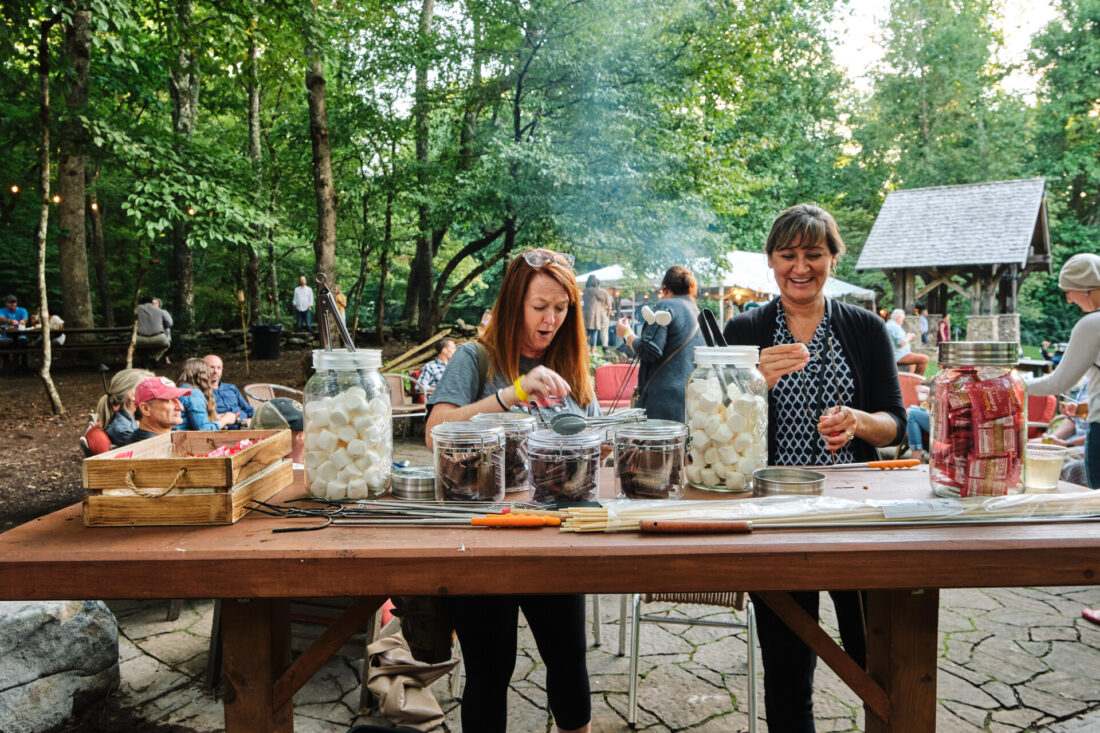
“During peak fire season, we have a dedicated s’mores basket at the ready,” Jenny Everett says. “It’s from a second-hand shop and lined with a pretty plaid cloth. It’s always filled with a sleeve or two of grahams, big fluffy marshmallows, and Hershey’s bars so we’re never caught unprepared when the kids start chanting, ‘We want s’mores!’”
Chef Evans in Jackson, Mississippi, loves to replace the plain chocolate with a Reese’s peanut butter cup. And at Cavalry Court hotel in Texas, the staff offers up peppermint patties for “grasshopper” s’mores. North Carolina’s Frank Scibelli sometimes swaps in a shmear of Nutella.
Find tons more reader tips and tricks for s’mores here.
Get sentimental about your sips.
“Not everything that Covid ushered in is a disaster,” says the Mississippi poet Beth Ann Fennelly. “For example? Gathering pals for mulled wine. From 2016 to 2020, my husband and I spent a chunk of December in Baden Wurtemberg, a state in the southern part of Germany, as my husband’s novel, Crooked Letter, Crooked Letter, was being read by high school students there. While he spoke to the students, I hit up the Christmas markets, sipping on delicious mulled wine as I strolled the booths filled with ornaments and handicrafts.
When Covid arrived, we moved all entertaining outdoors. Thank God for our firepit. For a friend’s birthday in December, knowing we had to be outside, I made a big batch of mulled wine so we could host a group and warm up from the inside out while telling stories over the flames and admiring the wintry constellations.
We don’t need to be outside these days—but Covid reminded me that it’s energizing to feel the brisk night air, warming one’s palms on the mug, inhaling the aroma of cloves and cinnamon, and hearing the flames crackle. Doesn’t everyone look slightly lovelier in the rose glow of a fire? Mulled wine is a laid-back concoction, tolerant of substitutions, but here’s a recipe to get you started.”
For something even more potent, consider this spiked cider from High Wire Distilling Co.’s Ann Marshall: Combine four cups apple cider, one lemon sliced into rounds, six cloves, a half teaspoon of ground allspice, two cinnamon sticks, and an orange peel. Heat it all to a simmer and then pour a ladleful over individual cups, each filled with an ounce and a half of bourbon—Marshall suggests High Wire’s Revival Rye Whiskey.
Safety first…and last.
North Carolina chef Bill Smith has some plain-spoken wisdom: “Don’t mess with a fire if you’re drunk,” he says. “You’re bound to either set the lawn on fire or to wander off without putting it out. Oh, and don’t wear one of those straw hula skirts. Long story short: She was okay and she had a bikini underneath.”
“It sounds obvious,” says digital editor Elizabeth Florio, “but when you’re ready to call it a night, put the thing out. All the way out. Even one ember can be carried by a gust of wind and cause devastating damage. Douse it, then come back in ten minutes and douse it again.”
But above all, Ann Marshall says it best: “Have a meaningful conversation. Tell stories. Share memories, hopes, dreams. A good fire should stir the reaches of your imagination, transport you to good times past, and sometimes inspire thoughtful silence. Sing quiet songs. Practice your harmonies. Share a scratchy old wool blanket. Gaze at the fire. Listen to the fire. Its embers tell an ancient story that is now also your story.”


